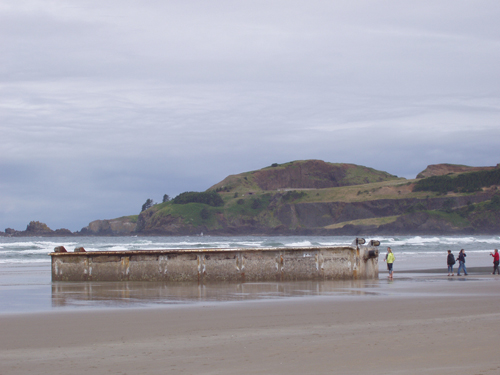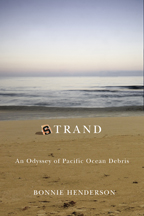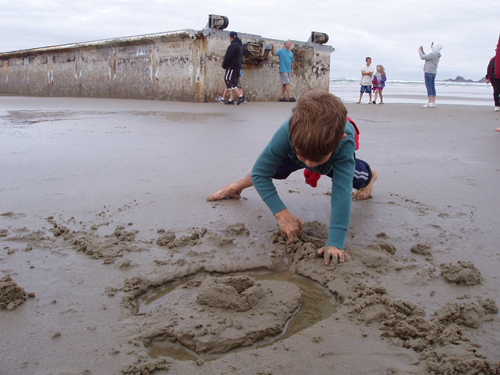We're pleased to welcome author Bonnie Henderson to the OSU Press blog. In her book Strand: An Odyssey of Pacific Ocean Debris, she traces wrack collected on a mile of Oregon beach, some of which had travelled from as far as Hokkaido, Japan. Today she reflects on the tsunami wreckage that has begun to wash up on Oregon's coastline and on what the future might hold for Oregon. The photographs were taken after large quantities of flora and fauna, including potentially invasive species, were scraped from the sides of the dock.
A large concrete dock, wrenched from the port at Misawa, Japan, by a massive tsunami 15 months earlier lands on the beach north of Newport, Oregon. A columnist f rom the local paper gives me a call. He’s struck by what he sees as a lack of reverence by tourists and locals for this object, which to him represents the thousands of lives lost in that cataclysm. He’s interested in a quote from the author of Strand: An Odyssey of Pacific Ocean Debris.
rom the local paper gives me a call. He’s struck by what he sees as a lack of reverence by tourists and locals for this object, which to him represents the thousands of lives lost in that cataclysm. He’s interested in a quote from the author of Strand: An Odyssey of Pacific Ocean Debris.
“I think about what will be washing up in Japan when the earthquake and tsunami happens here,” I tell him. “What is the stuff that will be showing up there? Our docks, soccer balls and, unless a few schools are moved, our kids’ backpacks?”
I believe he thinks I missed the point. I tend to think he did.
The debris from the March 11, 2011, tsunami has sparked great interest on this side of the Pacific in the stream of garbage that circulates in the North Pacific and that sometimes gets stuck in what’s known as the Great Pacific Garbage Patch. Many more people are now attuned to the North Pacific Gyre, a collection of currents that move like a river in the ocean in a great clockwise pattern around the northern Pacific Ocean. The gyre has always carried durable debris, notably the glass floats that Japanese fishermen used to use in great quantities and would lose or would intentionally discard, to make room in the holds for fish, before most of them switche d to plastic floats. Since the advent of container shipping and the explosion of plastic manufacturing, the quantity of plastic garbage in the gyre has exploded. Fish eat it. Birds, skimming the ocean’s surface, eat it, or they dive and eat the plastic-stuffed fish below. Most such debris floats just under the surface of the water, and thus floats at the speed of the current. Some—the dock from Misawa, notably—rides higher in the water and thus gets an assist from prevailing winds, which blow it faster than the speed of the water. The Pacific Ocean is vast. Debris that lands in the water immediately starts to spread out, and scientists now estimate that the debris from the 2011 tsunami in Japan now covers an area equivalent to three times the area of the continental United States.
d to plastic floats. Since the advent of container shipping and the explosion of plastic manufacturing, the quantity of plastic garbage in the gyre has exploded. Fish eat it. Birds, skimming the ocean’s surface, eat it, or they dive and eat the plastic-stuffed fish below. Most such debris floats just under the surface of the water, and thus floats at the speed of the current. Some—the dock from Misawa, notably—rides higher in the water and thus gets an assist from prevailing winds, which blow it faster than the speed of the water. The Pacific Ocean is vast. Debris that lands in the water immediately starts to spread out, and scientists now estimate that the debris from the 2011 tsunami in Japan now covers an area equivalent to three times the area of the continental United States.
That’s part of the science story. What about the reverence? There’s a science story there too.
Certain geologists and seismologists in Japan had been predicting a mega-quake of this kind for that part of Japan for several years, though their warnings had not been taken seriously by the Japanese government. Japan is no stranger to earthquakes, but the last major one in this particular location was in AD 869. We have a similar situation in the Pacific Northwest. There is no longer any doubt that similar seismic events—just as big, just as devastating, triggered by the same kind of collision of tectonic plates—have occurred here in the past and will occur here in the foreseeable future. Right here, from southern Vancouver Island, B.C., down to Eureka, California, or—in the cast of a partial rupture—from about Coos Bay down to Eureka. The last one was much more recent than AD 869; it was just 312 years ago, in January 1700. Humans living on this coast at that time—those who survived the event—memorialized it in their stories. And the earth recorded it in layers of estuary mud and sediment and ocean sand.
With its history of frequent earthquakes, Japan has developed an infrastructure that is better prepared for such events than that of any country in the world. Still, as many as 20,000 lives were lost in the March 2011 event—with thousands still counted as missing, there is no definitive tally. The vast majority of those deaths were caused not by the earthquake but by the tsunami that followed close behind.
It seems to me that the best way to honor those lost souls on this side of the Pacific is to take seriously the mirror-image threat that we face and to do our best to save lives here. We can prepare for it by moving schools and hospitals out of the inundation zone and by rebuilding bridges to withstand a magnitude 9 earthquake. Those bridges will be a lifeline for people fleeing the coming tsunami after the earthquake rumbles its warning. To ignore the science and fail to prepare here is to devalue the lives of our fellow humans claimed by another tsunami in another country on the other side of the Pacific.
 Docks, yes. Plastic water and soda bottles, certainly, and plastic toys and containers and items of all kinds. Boats. Wood from houses. All this and much more will find its way into the North Pacific Gyre after the tsunami here—whether it strikes this year or in 50 or 100 years. Some of that debris from our houses and businesses and parks and schools may eventually get blown onto the beach on northern Honshu, or maybe Hokkaido, and beachcombers there will no doubt have the same range of reactions our fellow citizens have had to the dock from Misawa, from annoyance to curiosity to reverence. But none of them will doubt that the kind of event that sent this debris from the West Coast of the United States to the coast of Japan can happen there.
Docks, yes. Plastic water and soda bottles, certainly, and plastic toys and containers and items of all kinds. Boats. Wood from houses. All this and much more will find its way into the North Pacific Gyre after the tsunami here—whether it strikes this year or in 50 or 100 years. Some of that debris from our houses and businesses and parks and schools may eventually get blown onto the beach on northern Honshu, or maybe Hokkaido, and beachcombers there will no doubt have the same range of reactions our fellow citizens have had to the dock from Misawa, from annoyance to curiosity to reverence. But none of them will doubt that the kind of event that sent this debris from the West Coast of the United States to the coast of Japan can happen there.
They know it can. They have felt it, have seen it. And they know it will happen again.
Bonnie Henderson is currently at work on a book about how we know what we know about earthquakes and tsunamis in the Cascadia Subduction Zone.
Related Titles

Strand
In Strand, travel writer and amateur naturalist Bonnie Henderson traces the stories of wrack washed up on the mile-long stretch of Oregon beach she walked...
